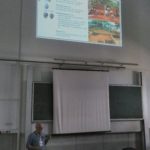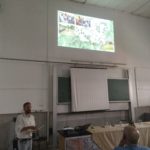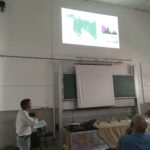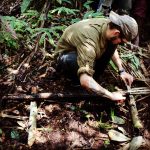 On May 17th
On May 17th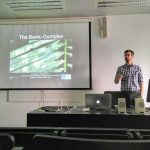 Dr. Chris Kiahtipes (University of South Florida, Tampa, USA) presented his view on how interdisciplinary research in archaeology and paleo-ecology may contribute to the reconstruction of vegetation and population dynamics in the Central African rainforest and to a better understanding of the ways in which these two processes have interacted through time. He highlighted interesting parallels with similar research in the North American Great Basin and emphasized the theoretical implications of past research on the Fremont Complex for future research on the Bantu Expansion. During his talk he also presented the first pollen records ever obtained from the central parts of the Congo Basin. The BantuFirst team was very happy to welcome colleagues from the UGent Departments of Archaeology and Biology, the Université libre de Bruxelles (ULB), the Royal Museum for Central Africa (RMCA) and several other people. Abstract
Dr. Chris Kiahtipes (University of South Florida, Tampa, USA) presented his view on how interdisciplinary research in archaeology and paleo-ecology may contribute to the reconstruction of vegetation and population dynamics in the Central African rainforest and to a better understanding of the ways in which these two processes have interacted through time. He highlighted interesting parallels with similar research in the North American Great Basin and emphasized the theoretical implications of past research on the Fremont Complex for future research on the Bantu Expansion. During his talk he also presented the first pollen records ever obtained from the central parts of the Congo Basin. The BantuFirst team was very happy to welcome colleagues from the UGent Departments of Archaeology and Biology, the Université libre de Bruxelles (ULB), the Royal Museum for Central Africa (RMCA) and several other people. Abstract
Blog
New archaeobotanical and palaeoenvironmental research
On April 1, 2019, Dr. Wannes Hubau joined the BantuFirst team. He is responsible for the project’s archaeobotanical and palaeoenvironmental research.
Contested Millets in Africa and Asia: Past and Present
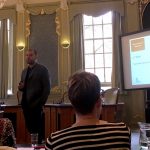 On March 28-29, 2019, Koen Bostoen, Sifra Van Acker and Sara Pacchiarotti participated in the International Workshop on “Contested Millets in Africa and Asia: Past and Present” in Groningen (Netherlands), which was organized by Peter Berger (University of Groningen) and Roland Hardenberg (Frobenius Institut für Kulturanthropologische Forschung an der Goethe-Universität Frankfurt). They presented an invited lecture titled “On the rise and fall of millets in Bantu speech communities of Central Africa: Insights from historical linguistics and archaeology“, which included preliminary results from Sifra’s ongoing historical-linguistic PhD research within the BantuFirst project.
On March 28-29, 2019, Koen Bostoen, Sifra Van Acker and Sara Pacchiarotti participated in the International Workshop on “Contested Millets in Africa and Asia: Past and Present” in Groningen (Netherlands), which was organized by Peter Berger (University of Groningen) and Roland Hardenberg (Frobenius Institut für Kulturanthropologische Forschung an der Goethe-Universität Frankfurt). They presented an invited lecture titled “On the rise and fall of millets in Bantu speech communities of Central Africa: Insights from historical linguistics and archaeology“, which included preliminary results from Sifra’s ongoing historical-linguistic PhD research within the BantuFirst project.
Equatorial Guinea: exploratory mission, November-December 2018
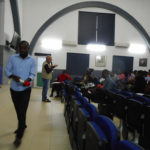 Subsequent to preliminary contacts with the National Center for Scientific Research of Equatorial Guinea (CICTE : Centro de Investigaciones Cientificas y Tecnologicas), Prof. Bernard Clist carried out in Malabo a one-week exploratory mission funded by the French Ministry for Foreign Affairs (26 November-2 December). The aim of this visit was to develop the Center’s interest in starting Iron Age archaeological research in conjunction with historical linguistic research, on Bioko Island in a first phase and later on on the mainland. The research project aims to uncover the very poorly understood cultural sequence of Bioko island which may have started off around 4,000-3,000 bp. This sequence is in direct relationship with the earliest expansion of Bantu speech communities and villages through Central Africa which the BantuFirst project is trying to identify south of the rainforest in the Democratic Republic of Congo around 2500 bp. In addition to fruitful meetings with the CICTE board of directors, Bernard Clist gave two conferences about our archaeological knowledge of the history of Equatorial Guinea, one at the French school, the other at the National University (see picture).
Subsequent to preliminary contacts with the National Center for Scientific Research of Equatorial Guinea (CICTE : Centro de Investigaciones Cientificas y Tecnologicas), Prof. Bernard Clist carried out in Malabo a one-week exploratory mission funded by the French Ministry for Foreign Affairs (26 November-2 December). The aim of this visit was to develop the Center’s interest in starting Iron Age archaeological research in conjunction with historical linguistic research, on Bioko Island in a first phase and later on on the mainland. The research project aims to uncover the very poorly understood cultural sequence of Bioko island which may have started off around 4,000-3,000 bp. This sequence is in direct relationship with the earliest expansion of Bantu speech communities and villages through Central Africa which the BantuFirst project is trying to identify south of the rainforest in the Democratic Republic of Congo around 2500 bp. In addition to fruitful meetings with the CICTE board of directors, Bernard Clist gave two conferences about our archaeological knowledge of the history of Equatorial Guinea, one at the French school, the other at the National University (see picture).
18th Meeting of the Congo Basin Forest Partnership
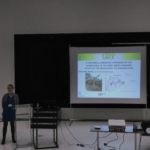
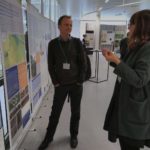
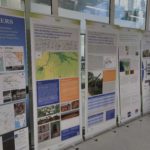 On November 27, 2018, on-going research of the BantuFirst team was presented in Tervuren at the 18th Meeting of Partners of the Congo Basin Forest Partnership, which focused on the environmental dynamics of the Congo Basin.
On November 27, 2018, on-going research of the BantuFirst team was presented in Tervuren at the 18th Meeting of Partners of the Congo Basin Forest Partnership, which focused on the environmental dynamics of the Congo Basin.
Dirk Seidensticker and Katharina Jungnickel presented a poster titled “New Archaeological Research on the Earliest Remains of Sedentary Groups South of the Central-African Rainforest”, which highlighted the preliminary results of the project’s first fieldwork conducted during the summer of 2018. The study area, which has received very little attention from archaeologists so far, is situated in between the Congo Basin and the Lower Congo region. The chrono-cultural sequences of these two areas are impossible to link on the basis of existing collections.
A second poster titled “Historical-Linguistic Approach to the Subsistence of the First Bantu Speakers South of the Rainforest: The Banana Case” was presented by Sifra Van Acker and co-authored by Sara Pacchiarotti and Koen Bostoen. This poster presented preliminary results of Sifra’s ongoing PhD research on the reconstruction of subsistence-related vocabulary in Proto-West-Coastal-Bantu as part of the project’s wider historical-comparative linguistic research. The banana case is highly relevant because it is still not clear when, how and by whom bananas were introduced in Africa and which role they played in the diet of early Bantu speakers and in the expansion of their languages through Central Africa.
The BantuFirst project in the Kongo Central Province (DRC): archaeological and paleo-environmental research from September to November 2018
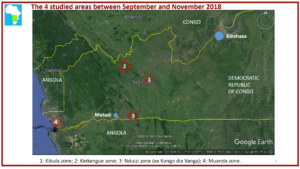
In close cooperation with the Institut des Musées Nationaux du Congo (IMNC), archaeological and paleo-environmental fieldwork was carried out from September 20 to November 24, 2018 in the Kongo-Central province of the DRC. The mission was carried out by Prof. Bernard Clist (mission leader, Ghent University), Clément Mambu Nsangathi (IMNC), Isidore Nkanu Nsasa (driver), and Suzanne Bigohe Mugisha (student from Kinshasa University).
The objectives of the mission were: (i) to gather more information from the Neolithic and Early Iron Age archaeological sites excavated in 1951, 1984 and 2015 by M. Bequaert, P. de Maret and B. Clist, respectively; (ii) to investigate possible ancient shell middens along the Atlantic Ocean coast and in the ‘Parc Marin des Mangroves’ along the Congolese banks of the Congo river; (iii) to carry out surveys to locate new sites to be excavated; (iv) to sample a maximum of ancient village pits to identify crops by carrying out flotations; and (v) to extract soil samples from as deep as possible to understand past vegetation changes. All of these objectives aim at a better understanding of the social and economic dynamics of the earliest villages settling the Kongo-Central province between the Atlantic coast and Kinshasa.
During the fieldwork period, we traveled 3,267 km, identified and documented 64 new archaeological sites dating from the Middle Stone Age to the Late Iron Age in the 4 selected study zones (Figure 1), and excavated 10 ancient hunter-gatherer, village and iron working sites. We were oriented to 4 sites by previous research (M. Bequaert, P. de Maret, B. Clist). However, new large-scale surveys around Kinkenge, Muanda and Nduizi (formerly Kongo dia Vanga) enabled us to excavate 6 new settlements. The surveys were strengthened by systematically interviewing farmers we met while walking through the fields and villages, after we showed them samples of broken pottery. These interviews sometimes led to the identification of promising sites, e.g. Muanda 6 on the coast.
Small scale archaeological excavations were carried out at Sakuzi (zone 1), Kindu and Mantsetsi (zone 2), Nduizi, Nguemba 1, Mbanza 2A, and Mbanza 2B (zone 3), and Boma1, Katala, Muanda 6, and Muanda 13 (zone 4). Soil sampling was conducted at the Kindu, Mantsetsi, Mbanza 2, and Muanda 6 sites, and pit sampling at the Kitala, Mbanza 2, Nduizi, Nguemba 1, and Sakuzi sites.
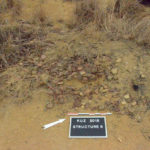

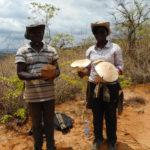
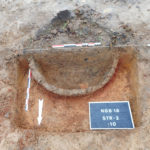
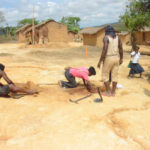
Stone Age: Very interesting data related to the Stone Age was collected at Boma 1. It consists mainly of quartz flakes, blades and cores found at -6.20 meters in a large borrow pit by the Boma-Muanda road. Stone artefacts, probably younger, were found stratified at Kindu and Mantsetsi down to -2 meters. Charcoals collected in situ, Carbon-13 (13C) analysis of soils, and the study of artefacts will give new insights on this epoch.
Neolithic and Ancient Iron Age: Most of the finds relate to this period due to the orientation of the BantuFirst project, roughly between 2,400 and 1,500 BP. Excavations at Kindu, Mantsetsi, Nduizi, and Sakuzi aimed at obtaining new data after prior excavations dating back to 1951 and 1984. Crucially, new pottery styles were identified in several pits at Nduizi and Sakuzi. Their study will certainly expand our preliminary understanding of the first villages to have settled the Kongo-Central Province.Apart from a poorly documented archaeological mission by the IMNC in 1986, we were the first to survey and excavate the area near the coast, west of Matadi, specifically between Boma and Muanda. At Muanda 6, systematic dry sieving yielded fish and small mammal bones associated to shell beads. Preliminary on-site analysis suggests that the Muanda style pottery is the oldest found in the lower level of Katala, at Muanda 6, and near the border to Cabinda at Muanda 8. It is followed by the Katala style of pottery found stratified under the present-day village and above the Muanda style level. We are now waiting for Carbon-14 (14C) dates to understand where the Muanda and Katala styles stand within the pottery cultural sequence of the Kongo-Central province.
Late Iron Age: The analysis of surface-collected pottery in the four surveyed areas will enable us to develop local cultural sequences. Such sequences will be informative in isolating interesting Ancient Iron Age sites to be excavated in 2019.
Linguistic fieldwork in the region of Kinshasa (DRC)
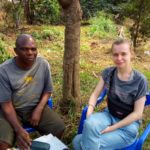
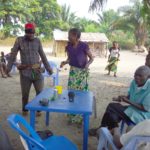
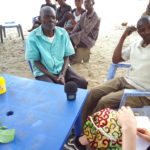
Flore Bollaert (MA African Studies, UGent) carried out linguistic fieldwork in the region of Kinshasa (DRC) in August 2018 as part of her MA research. She is carrying out a comparative study of the noun class systems of the Nzebi (B50), Mbete (B60) and Teke (B70) languages of West-Coastal/ West-Western Bantu. The objective of her fieldwork was to collect new data on some Teke languages, since these are underrepresented in the existing literature. She collected the bulk of her data in Mbankana, a small town approximately 150 km east of Kinshasa. She primarily worked with Joseph Emboto, who was her main consultant, but she also met and spoke to several other people. In Mbankana, Flore collected data on Bwala, an undescribed and undocumented Teke variety. Additionally, she collected in Kinshasa some data on Wumbu (B78), another Teke variety, in collaboration with native speaker Edouard Mbabu.
15th Congress of the PanAfrican Archaeological Association for Prehistory and Related Studies in Rabat, Morocco
The project’s aims and first results have been presented at the 15th Congress of the PanAfrican Archaeological Association for Prehistory and Related Studies in Rabat (Morocco) on September 12, 2018. Bernard Clist discussed “The first villages of Central Africa before 1500 BP” while Dirk Seidensticker presented “New archaeological research on the earliest villages south of the Central-African rainforest”. The two presentations were part of a special session organized by Bernard Clist, Pierre de Maret and Thomas Huffman covering “Early villages and farming through African humid forests, from Central Africa southwards”.
The presentation of Bernard Clist gave an overview of Pre- and Early Iron Age groups in the western parts of Central Africa, especially in Gabon and the coastal areas of the two Congo states. The presentation included a detailed discussion of the known remains of past subsistence strategies. Dirk Seidensticker presented the first results of the project’s 2018 archaeological fieldwork campaign by himself and Katharina Jungnickel, including the first excavation of the site of Mukila since 1952 and the first-ever survey along the road from Kinshasa to Bandundu. Due to the virtually total lack of archaeological research within the Mai-Ndombe, Kwango and Kwilu provinces of the Democratic Republic of the Congo, these new findings will be pivotal for establishing the basis for future research.
24th Annual Meeting of the European Association of Archaeologists (EAA2018) in Barcelona, Spain
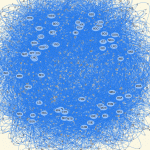 During the EAA meeting of 2018 Dirk Seidensticker, together with Florian Thiery, Allard Mees (both Römisch-Germanisches Zentralmuseum Mainz) and Clemens Schmid (Kiel University) presented their research on “RDF based modeling of relative and absolute chronological data: Examples from the central african rainforest and roman periodisation”. The method presented untangles hidden assumptions that are part of the way archaeologists build chronologies. Chronological intervals are sometimes based on absolute “certain” datings (e.g. C14) or derived from relative dating or combinations of both. Chronological relations between entities are modeled using Allen`s interval algebra within a RDF graph in order to produce a machine readable and processable semantic representation. The presentation can be accessed via Zenodo and the code is available via GitHub.
During the EAA meeting of 2018 Dirk Seidensticker, together with Florian Thiery, Allard Mees (both Römisch-Germanisches Zentralmuseum Mainz) and Clemens Schmid (Kiel University) presented their research on “RDF based modeling of relative and absolute chronological data: Examples from the central african rainforest and roman periodisation”. The method presented untangles hidden assumptions that are part of the way archaeologists build chronologies. Chronological intervals are sometimes based on absolute “certain” datings (e.g. C14) or derived from relative dating or combinations of both. Chronological relations between entities are modeled using Allen`s interval algebra within a RDF graph in order to produce a machine readable and processable semantic representation. The presentation can be accessed via Zenodo and the code is available via GitHub.
7th International Conference on Bantu languages and 48th Colloquium on African Languages and Linguistics
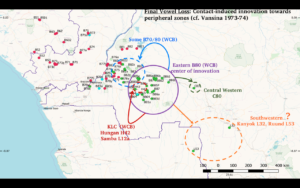 Progress on the historical linguistic side of the project was presented by Sara Pacchiarotti and Koen Bostoen at the 7th International Conference on Bantu languages (SINTU 7) in Cape Town and at the 48th Colloquium on African Languages and Linguistics (CALL) 2018 in Leiden.
Progress on the historical linguistic side of the project was presented by Sara Pacchiarotti and Koen Bostoen at the 7th International Conference on Bantu languages (SINTU 7) in Cape Town and at the 48th Colloquium on African Languages and Linguistics (CALL) 2018 in Leiden.
The talk at SINTU presented preliminary results on final vowel loss in West-Coastal/West-Western Bantu languages belonging to Guthrie’s groups B50, B60, B70 and B80. Through historical comparative work, we believe that this sound change occurred systematically in some B70 and B80 languages, but not in B50 and B60. Currently, we posit that B80 languages spoken in the eastern part of Congo DRC, such as Yans (B85), Nsong (B85d), Ding (B86), Lwel (B862), Mpiin (B863), Mbuun (B87) and Nzadi (B865), were the center of innovation for final vowel loss. This historical sound change then petered out through contact towards some B70 languages spoken in the western part of Congo DRC (e.g. Teke Tio Bali B75, some East Teke B76 varieties and some South Teke B78 varieties), some languages belonging to the Kikongo Language Cluster (e.g. Hungan H42, Samba L12a), and possibly some Central Western languages, such as Bushoong (C83).
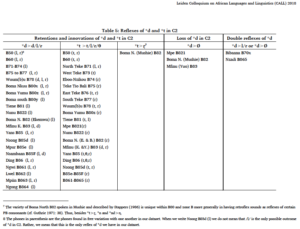 The talk at CALL presented a preliminary assessment of diagnostic sound changes for the internal classification of West-Coastal/West-Western Bantu languages belonging to Guthrie’s groups B50, B60, B70 and B80. We observe that most Proto-Bantu consonants in C(onsonant) 1 position are maintained in these groups. In C(onsonant) 2 position, however, several consonants undergo mergers, simplification or are completely lost in some B70 and B80 languages. This tendency to lose/reduce segments in C2 position results in very eroded reflexes of reconstructed Proto-Bantu forms and is additionally “aggravated” by the loss of final vowels in some languages within these two groups. Tentatively, B50-60 languages appear to be more conservative than B70 and B80. They retain consonants in C2 position which are lost or undergo mergers in B70-80. Moreover, B50-60 languages were not affected by systematic final vowel loss. Guthrie’s B70 group appears to be fragmented, with West Teke B73 often patterning with Guthrie’s B50-60 and South and East Teke (B77, B78 and B76 respectively) patterning with B80. Lastly, Guthrie’s B80 appears to be at least two separate groups on the basis of shared phonological innovations (i.e. B81-B83 except Boma Yumu B80z vs. B85-87+ Boma Yumu B80z).
The talk at CALL presented a preliminary assessment of diagnostic sound changes for the internal classification of West-Coastal/West-Western Bantu languages belonging to Guthrie’s groups B50, B60, B70 and B80. We observe that most Proto-Bantu consonants in C(onsonant) 1 position are maintained in these groups. In C(onsonant) 2 position, however, several consonants undergo mergers, simplification or are completely lost in some B70 and B80 languages. This tendency to lose/reduce segments in C2 position results in very eroded reflexes of reconstructed Proto-Bantu forms and is additionally “aggravated” by the loss of final vowels in some languages within these two groups. Tentatively, B50-60 languages appear to be more conservative than B70 and B80. They retain consonants in C2 position which are lost or undergo mergers in B70-80. Moreover, B50-60 languages were not affected by systematic final vowel loss. Guthrie’s B70 group appears to be fragmented, with West Teke B73 often patterning with Guthrie’s B50-60 and South and East Teke (B77, B78 and B76 respectively) patterning with B80. Lastly, Guthrie’s B80 appears to be at least two separate groups on the basis of shared phonological innovations (i.e. B81-B83 except Boma Yumu B80z vs. B85-87+ Boma Yumu B80z).
Some aspects of this new research have been incorporated in an interactive map that can be found here: West-Coastal Bantu Interactive Map.
